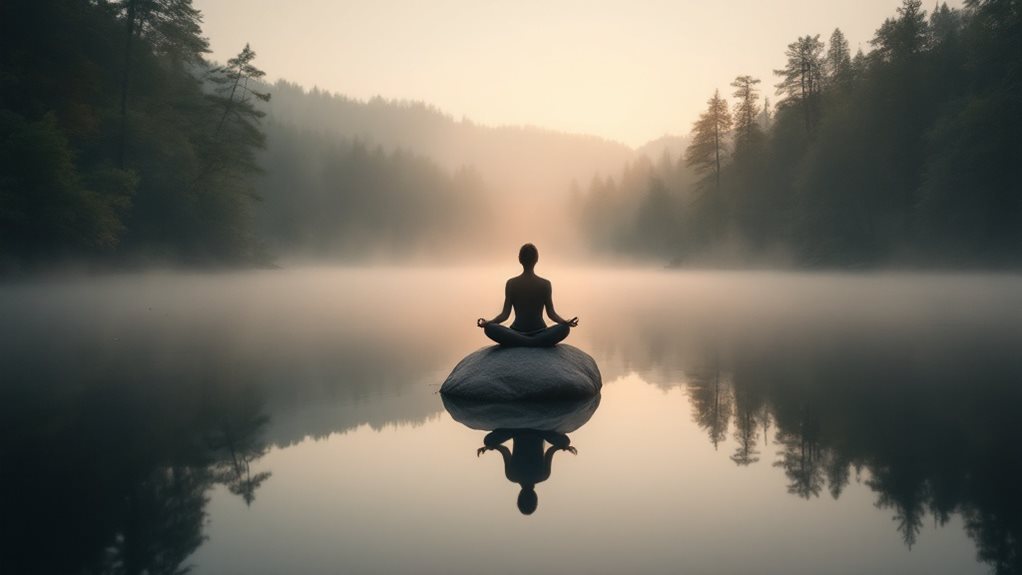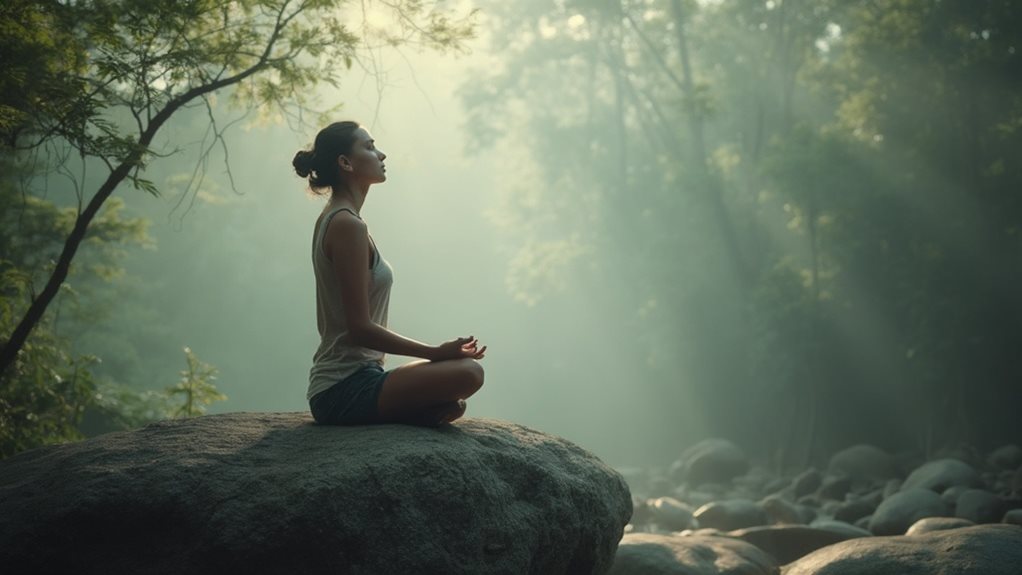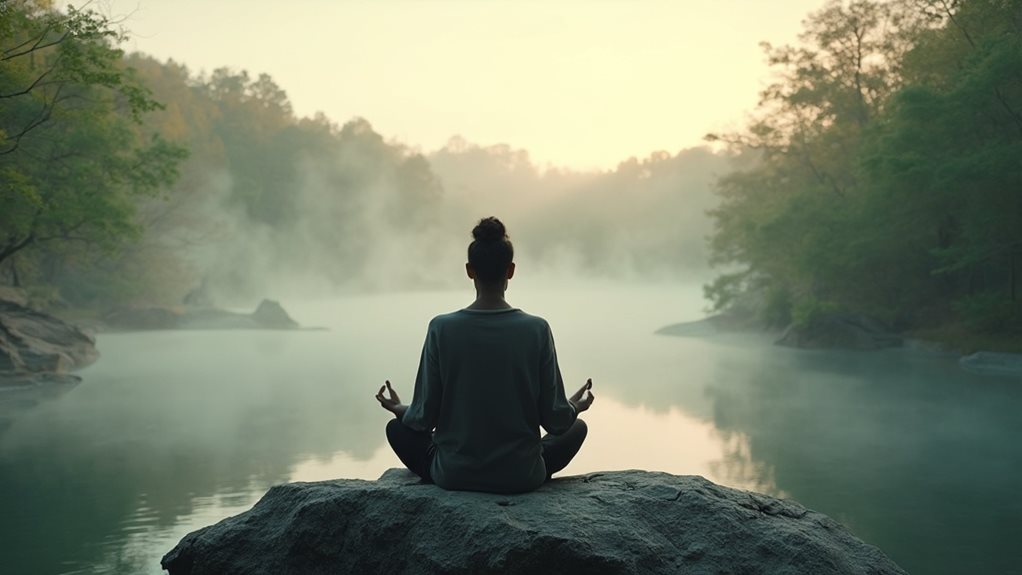
To master mindfulness, you'll need to understand its essence: being present in the moment and welcoming each experience without judgment. Discovering why mindfulness matters to you can deeply anchor your practice, making it more meaningful and resilient. Start by integrating simple, mindful practices into your daily routine and create a serene space dedicated to your mindfulness sessions. Remember, the simple act of focusing on your breath can transport you to a state of peace. Let's explore deeper as we continue on this path.
Key Takeaways
- Identify your personal motivations for practicing mindfulness to enhance commitment and depth in your practice.
- Integrate mindfulness into your daily routine through journaling and gratitude reflections.
- Design a dedicated, tranquil space for mindfulness to foster consistency and focus.
- Utilize mindful breathing techniques to anchor yourself in the present and reduce stress.
- Embrace a non-judgmental attitude towards your thoughts and feelings to cultivate deeper self-awareness and acceptance.
The Essence of Mindfulness Practice

Mindfulness practice invites you to cultivate a deep sense of awareness, focusing on your thoughts, emotions, and sensations without harsh judgment.
You'll discover the mindfulness benefits of enhanced mental clarity, emotional stability, and reduced stress.
Yet, common mindfulness misconceptions might lead you to believe it requires emptying your mind or hours of meditation daily.
In truth, it's about being present and accepting each moment as it unfolds.
This gentle approach helps you connect deeply with the present, fostering a tranquil inner environment.
Embrace this practice with patience and openness, allowing the transformative effects to enrich your daily life.
Discovering Your Personal Why for Mindfulness
Why do you turn to mindfulness? Discovering your personal why is essential.
It's not just about following a trend; it's about understanding the deep, personal motivations that draw you to this practice.
Here's why understanding your purpose matters:
- It fuels commitment when motivation wanes.
- It highlights the mindfulness benefits most essential to you.
- It guides your journey, making practice personally meaningful.
- It helps navigate challenges, keeping you focused and resilient.
As you explore mindfulness, let your personal why be your anchor, enhancing the transformative power of each mindful moment.
Strategies for Incorporating Mindfulness Into Your Daily Routine

Having established your personal reasons for practicing mindfulness, it's time to integrate these practices into your everyday life.
Start with mindful journaling each morning. Spend a few minutes recording your thoughts and feelings, observing them without judgment. This sets a reflective tone for your day.
Additionally, incorporate a gratitude practice into your evenings. Reflect on three things you're grateful for daily. This not only shifts your focus to positivity but also enhances your overall mental well-being.
These simple, yet powerful, habits anchor mindfulness into your routine, helping you maintain a calm and centered approach throughout your day.
Designing Your Mindfulness Space
As you commence on this journey of self-discovery and inner peace, creating a dedicated space for mindfulness practice can greatly enhance your experience.
A tranquil atmosphere isn't just beneficial; it's essential. Here's how to bring it to life:
- Choose a Quiet Corner: Free from daily distractions, where tranquility can take root.
- Incorporate Mindful Decor: Select items that resonate with serenity—perhaps a soft-colored mat or gentle artwork.
- Soft, Natural Lighting: Create a soothing ambiance that calms your mind.
- Comfortable Seating: Guarantee it supports your posture and allows you to relax fully.
Embrace this space as your sanctuary.
Techniques for Effective Mindful Breathing

To master mindfulness, it's essential to develop effective breathing techniques that anchor you in the present moment.
Begin with deep breathing exercises: inhale slowly through your nose, allowing your belly to expand, then exhale gently through your mouth, releasing all the tension.
Integrate mindful pauses throughout your day. During these pauses, focus solely on your breath, feeling each inhalation and exhalation as a grounding experience.
This practice not only calms your mind but also connects you deeply with the here and now.
Let each breath guide you back to a state of peace and presence.
Cultivating Awareness of Body and Thoughts
Cultivating awareness of your body and thoughts is a transformative step in your mindfulness journey.
By tuning into your physical sensations and observing your thought patterns, you create a deeper connection with your inner self.
Here's how you can start:
- Focus on Breath: Feel each inhale and exhale, noticing how your body moves with the breath.
- Body Scans: Slowly scan from head to toe, observing any tension or comfort.
- Observe Thoughts: Watch your thoughts as they come and go, without engagement.
- Regular Check-ins: Pause periodically throughout your day to reconnect with your body awareness and thought patterns.
This mindful practice fosters a calming clarity.
Emotional Wisdom Through Mindful Observation

Building on the awareness of your body and thoughts, you can now explore the deeper layers of emotional intelligence through mindful observation. By focusing your attention on your emotions, you cultivate emotional resilience. Observing without judgment leads to mindful acceptance, which is key to understanding and managing your feelings effectively.
Here's a straightforward guide to help:
| Practice | Benefit |
|---|---|
| Non-judgmental observation | Enhances understanding of emotions |
| Mindful acceptance | Reduces emotional reactivity |
| Regular reflection | Builds emotional resilience |
| Compassionate awareness | Fosters deeper empathy |
| Emotion-focused meditation | Strengthens emotional regulation |
Embrace these practices to enhance your emotional wisdom.
Broadening Your Mindfulness Horizons
As you continue your journey in mindfulness, think about exploring new dimensions that may deepen your understanding and enhance your practice.
Exploring new methods can be both invigorating and enlightening. Here are a few techniques to think about:
- Mindful Journaling: Start or end your day by jotting down reflections and insights. It helps process emotions and fosters self-awareness.
- Gratitude Practice: Each night, list three things you're grateful for. This cultivates a positive mindset.
- Nature Walks: Engage all your senses as you walk; it connects you with the external world.
- Guided Meditations: Try different styles to find what resonates with you, expanding your perspective.
Frequently Asked Questions
How Does Mindfulness Impact Relationships With Others?
Mindfulness enhances your relationships by improving emotional connection and communication skills. You'll listen more attentively, respond thoughtfully, and understand others better, fostering deeper bonds and mutual respect in your interactions.
Can Mindfulness Practices Replace Sleep or Rest?
Mindfulness isn't a magical elixir that can replace sleep, but it's a tool to enhance restfulness. Understanding this clears up common mindfulness misconceptions about it being a sleep alternative. Prioritize both for ideal well-being.
Is Mindfulness Beneficial for Children or Teenagers?
Yes, mindfulness benefits children and teenagers by supporting their emotional and mental development. It helps them manage stress, enhance focus, and cultivate resilience, making it a valuable tool for their growth and well-being.
How Do Mindfulness Practices Influence Physical Health?
Mindfulness practices enhance your physical health by reducing stress, improving sleep, and boosting immunity. You'll feel more present and connected, greatly uplifting your overall physical wellness. Embrace these benefits to nurture your body and mind.
What Are the Challenges of Teaching Mindfulness Effectively?
You'll find that effectively teaching mindfulness requires thoughtful curriculum development and maintaining student engagement, which can be challenging but deeply rewarding. Empathize with learners and adapt methods to their evolving needs.
Conclusion
You're on the brink of a life-altering revelation! By mastering mindfulness, you'll access an ocean of serenity within yourself. Remember, every breath is a step closer to profound peace and emotional wisdom. Embrace this journey with open arms and a willing heart. As you integrate mindfulness into each day, you'll find your life transformed in astonishing ways. Keep exploring, keep breathing deeply, and watch as the wonders of a mindful life unfold before you.

